
Ecology of the North Cascades
Encyclopedia

Rain shadow
A rain shadow is a dry area on the lee side of a mountainous area. The mountains block the passage of rain-producing weather systems, casting a "shadow" of dryness behind them. As shown by the diagram to the right, the warm moist air is "pulled" by the prevailing winds over a mountain...
effects of the mountain range. The North Cascades is a section of the Cascade Range
Cascade Range
The Cascade Range is a major mountain range of western North America, extending from southern British Columbia through Washington and Oregon to Northern California. It includes both non-volcanic mountains, such as the North Cascades, and the notable volcanoes known as the High Cascades...
from the South Fork of the Snoqualmie River
Snoqualmie River
The Snoqualmie River is a long river in King County and Snohomish County in the U.S. state of Washington. The river's three main tributaries are the North, Middle, and South Forks, which drain the west side of the Cascade Mountains near the town of North Bend and join near the town of Snoqualmie...
in Washington, United States
United States
The United States of America is a federal constitutional republic comprising fifty states and a federal district...
, to the confluence of the Thompson
Thompson River
The Thompson River is the largest tributary of the Fraser River, flowing through the south-central portion of British Columbia, Canada. The Thompson River has two main branches called the South Thompson and the North Thompson...
and Fraser River
Fraser River
The Fraser River is the longest river within British Columbia, Canada, rising at Fraser Pass near Mount Robson in the Rocky Mountains and flowing for , into the Strait of Georgia at the city of Vancouver. It is the tenth longest river in Canada...
s in British Columbia
British Columbia
British Columbia is the westernmost of Canada's provinces and is known for its natural beauty, as reflected in its Latin motto, Splendor sine occasu . Its name was chosen by Queen Victoria in 1858...
, Canada
Canada
Canada is a North American country consisting of ten provinces and three territories. Located in the northern part of the continent, it extends from the Atlantic Ocean in the east to the Pacific Ocean in the west, and northward into the Arctic Ocean...
, where the range is officially called the Cascade Mountains but is usually referred to as the Canadian Cascades. The North Cascades ecoregion is a Level III ecoregion in the Commission for Environmental Cooperation
Commission for Environmental Cooperation
The Commission for Environmental Cooperation was established by Canada, Mexico, and the United States to implement the North American Agreement on Environmental Cooperation , the environmental side accord to the North American Free Trade Agreement...
's classification system.
The terrain of the North Cascades is composed of high, rugged mountains. It contains the greatest concentration of active alpine glacier
Glacier
A glacier is a large persistent body of ice that forms where the accumulation of snow exceeds its ablation over many years, often centuries. At least 0.1 km² in area and 50 m thick, but often much larger, a glacier slowly deforms and flows due to stresses induced by its weight...
s in the conterminous United States and has a variety of climatic zones. A dry continental climate occurs in the east and mild, maritime, rainforest
Rainforest
Rainforests are forests characterized by high rainfall, with definitions based on a minimum normal annual rainfall of 1750-2000 mm...
conditions are found in the west. It is underlain by sedimentary
Sedimentary rock
Sedimentary rock are types of rock that are formed by the deposition of material at the Earth's surface and within bodies of water. Sedimentation is the collective name for processes that cause mineral and/or organic particles to settle and accumulate or minerals to precipitate from a solution....
and metamorphic rock
Metamorphic rock
Metamorphic rock is the transformation of an existing rock type, the protolith, in a process called metamorphism, which means "change in form". The protolith is subjected to heat and pressure causing profound physical and/or chemical change...
in contrast to the adjoining Cascades which are composed of volcanics.
The ecology of the area can be understood by following a west-to-east line at the southern end of the North Cascades, at approximately 47.5 degrees north. As the line passes through the Cascade range, it passes through a number of ecoregions, first getting higher and colder, then getting warmer, yet drier. Each of these component ecoregions can be described by either a tree indicator species
Indicator species
An indicator species is any biological species that defines a trait or characteristic of the environment. For example, a species may delineate an ecoregion or indicate an environmental condition such as a disease outbreak, pollution, species competition or climate change...
, or by a lack of trees: Western Hemlock
Western Hemlock
Tsuga heterophylla. the Western Hemlock, is a species of hemlock native to the west coast of North America, with its northwestern limit on the Kenai Peninsula, Alaska, and its southeastern limit in northern Sonoma County, California.-Habitat:...
, Silver Fir
Silver Fir
Abies alba, commonly known as the European silver fir, is a fir native to the mountains of Europe, from the Pyrenees north to Normandy, east to the Alps and the Carpathians, and south to southern Italy and northern Serbia.-Description:...
, Subalpine Mountain Hemlock
Mountain Hemlock
Tsuga mertensiana, known as Mountain Hemlock, is a species of hemlock native to the west coast of North America, with its northwestern limit on the Kenai Peninsula, Alaska, and its southeastern limit in northern Tulare County, California....
, Alpine
Alpine tundra
Alpine tundra is a natural region that does not contain trees because it is at high altitude. Alpine tundra is distinguished from arctic tundra, because alpine soils are generally better drained than arctic soils...
, Subalpine Fir, and Grand Fir
Grand Fir
Abies grandis is a fir native to the Pacific Northwest and Northern California of North America, occurring at altitudes of sea level to 1,800 m...
/Douglas-fir
Douglas-fir
Douglas-fir is one of the English common names for evergreen coniferous trees of the genus Pseudotsuga in the family Pinaceae. Other common names include Douglas tree, and Oregon pine. There are five species, two in western North America, one in Mexico, and two in eastern Asia...
.
Western Hemlock Ecoregion

Western Hemlock
Tsuga heterophylla. the Western Hemlock, is a species of hemlock native to the west coast of North America, with its northwestern limit on the Kenai Peninsula, Alaska, and its southeastern limit in northern Sonoma County, California.-Habitat:...
, Douglas-fir
Douglas-fir
Douglas-fir is one of the English common names for evergreen coniferous trees of the genus Pseudotsuga in the family Pinaceae. Other common names include Douglas tree, and Oregon pine. There are five species, two in western North America, one in Mexico, and two in eastern Asia...
, western red cedar and red alder
Red Alder
Alnus rubra, the Red alder, is a deciduous broadleaf tree native to western North America.-Description:It is the largest species of alder in North America and one of the largest in the world, reaching heights of 20–35 m. The official tallest red alder stands 32 meters tall in Clatsop County, Oregon...
. The understory is primarily composed of salal
Salal
Gaultheria shallon is a leathery-leaved shrub in the heather family , native to western North America. In English it is known as salal, shallon, or in Britain simply Gaultheria.-Ecology:...
, hazel
Hazel
The hazels are a genus of deciduous trees and large shrubs native to the temperate northern hemisphere. The genus is usually placed in the birch family Betulaceae, though some botanists split the hazels into a separate family Corylaceae.They have simple, rounded leaves with double-serrate margins...
, salmonberry
Salmonberry
Rubus spectabilis is a species of Rubus native to the west coast of North America from west central Alaska to California....
, Devil's Club
Devil's Club
Devil's Club is a large shrub primarily native to the cool moist forests of western North America, but also disjunct on islands in Lake Superior. It is noted for its large palmate leaves and erect, woody stems covered in brittle spines...
and Oregon grape. The western hemlock (Tsuga heterophylla) is an extremely shade tolerant tree and it is common to find its seedlings and saplings in the understories of the forest floors. It prefers moist temperate conditions. As conditions get dryer and colder they don’t fare as well. Western hemlocks can reach over 200 feet (61 m) in height with a diameter of 3 to 4 ft (0.9144 to 1.2 m). They can be identified by their drooping leader at the top of the tree. It is not uncommon to find western hemlocks growing in a row on a nurse log. The Western Hemlock Ecoregion offers an abundance of life. Black-tailed deer
Black-tailed Deer
Two forms of black-tailed deer or blacktail deer occupying coastal temperate rainforest on North America's Pacific coast are subspecies of the mule deer. They have sometimes been treated as a species, but virtually all recent authorities maintain they are subspecies...
graze in their understories. Fox, coyotes, cougars, and an assortment of herbivore mammals and birds can also be found in these low elevation forests.
Silver Fir Ecoregion
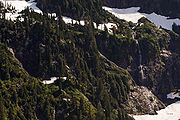
Pacific Silver Fir
Abies amabilis, commonly known as the Pacific silver fir, is a fir native to the Pacific Northwest of North America, occurring in the Pacific Coast Ranges and the Cascade Range from the extreme southeast of Alaska, through western British Columbia, Washington and Oregon, to the extreme northwest of...
and also contains Noble fir
Noble Fir
Abies procera, the Noble Fir, is a western North American fir, native to the Cascade Range and Coast Range mountains of extreme northwest California and western Oregon and Washington in the United States...
, Douglas-fir
Douglas-fir
Douglas-fir is one of the English common names for evergreen coniferous trees of the genus Pseudotsuga in the family Pinaceae. Other common names include Douglas tree, and Oregon pine. There are five species, two in western North America, one in Mexico, and two in eastern Asia...
, and Alaska yellow-cedar. Coarse woody debris
Coarse woody debris
Coarse woody debris is a term used in English-speaking countries for fallen dead trees and the remains of large branches on the ground in forests. Some prefer the term coarse woody habitat . A dead standing tree is known as a snag and provides many of the same functions as coarse woody debris...
is very characteristic of the Silver fir ecoregion, providing microsites for organisms. The Pacific Silver Fir zone is in some of the steepest parts of the topography and heavy snow often leads to avalanche gullies. In every major drainage basin along the western slopes of the Cascade Mountains there is evidence of avalanche tracks breaking up the forested vegetation with nonforested vegetation. These gullies provide sites of new successional growth as they move toward a coniferous forest again. Because of the dense forests of the Silver Fir ecoregion, it was the preferred area for commercial logging prior to designation of areas as wilderness.
The Pacific Silver Fir (Abies amabilis) is extremely tolerant of shade and does not fare as well in drought or warmer temperatures. It can grow as high as 180 feet (54.9 m) and reach 3 – in diameter. The understory communities of the Pacific Silver Fir can vary depending on moisture availability. Common understory shrubs include the Vine maple
Vine Maple
Acer circinatum is a species of maple native to western North America, from southwest British Columbia to northern California, always within 300 km of the Pacific Ocean coast....
, Salal
Salal
Gaultheria shallon is a leathery-leaved shrub in the heather family , native to western North America. In English it is known as salal, shallon, or in Britain simply Gaultheria.-Ecology:...
, Cascade Oregon grape, Blueberry
Blueberry
Blueberries are flowering plants of the genus Vaccinium with dark-blue berries and are perennial...
, Mountain Huckleberry
Huckleberry
Huckleberry is a common name used in North America for several species of plants in two closely related genera in the family Ericaceae:* Vaccinium* GaylussaciaHuckleberry may also refer to:-Plants:...
, Devil's Club
Devil's Club
Devil's Club is a large shrub primarily native to the cool moist forests of western North America, but also disjunct on islands in Lake Superior. It is noted for its large palmate leaves and erect, woody stems covered in brittle spines...
, and Fool's huckleberry
Menziesia
Menziesia is a genus of flowering plant in the family Ericaceae.Species include:* Menziesia ciliicalyx* Menziesia ferruginea - False azalea or Fool's huckleberry* Menziesia multiflora...
. Common understory herbs are Bear grass, Twin flower, Pipsissewa, Dwarf dogwood or bunchberry
Cornus canadensis
Cornus canadensis is a herbaceous member of the Cornaceae family...
, Bead lily, Trailing blackberry
Rubus ursinus
Rubus ursinus is a species of blackberry or dewberry known by the common names California blackberry/dewberry, Douglas berry, and Pacific blackberry/dewberry. It is native to western North America. This is a wide, spreading shrub or vine-bearing bush with prickly branches that can tip layer to...
, Low false Solomon’s seal
Maianthemum stellatum
Maianthemum stellatum is a species of flowering plant, native across North America generally from Alaska to California in the west and from Newfoundland to the central Appalachian Mountains in the east...
, Foam flower, Trillium
Trillium
Trillium is a genus of about 40–50 species of spring ephemeral perennials, native to temperate regions of North America and Asia....
, Oak Fern, and Lady fern. The microclimate of the understory is moderated by the forest canopy causing the conditions to be cooler and moister in the summer and warmer in the winter. Pacific Silver fir seedlings and saplings are often found growing under their own canopies or those of a mixed canopy forest. Along streams in this ecoregion, breaks in the forest are replaced by mountain alder
Grey Alder
Alnus incana is a species of alder with a wide range across the cooler parts of the Northern Hemisphere....
, willow
Willow
Willows, sallows, and osiers form the genus Salix, around 400 species of deciduous trees and shrubs, found primarily on moist soils in cold and temperate regions of the Northern Hemisphere...
and Vine maple
Vine Maple
Acer circinatum is a species of maple native to western North America, from southwest British Columbia to northern California, always within 300 km of the Pacific Ocean coast....
and herbs such as saxifrage
Saxifrage
Saxifraga is the largest genus in the family Saxifragaceae, containing about 440 species of Holarctic perennial plants, known as saxifrages. The Latin word saxifraga means literally "stone-breaker", from Latin + ...
, yellow willow-herb
Epilobium
Epilobium is a genus in the family Onagraceae, containing about 160-200 species of flowering plants with a worldwide distribution. They are generally abundant in the subarctic, temperate and subantarctic regions, whereas in the subtropics and tropics they are restricted to the cool montane biomes,...
, monkey flowers, and bluebells can be found. Mountain alder and Vine maple can also be found around lake edges and in areas of flat or gentle slopes, bogs, or marsh habitat. Examples of Pacific Silver Fir forests can be found in the Commonwealth Basin and the Snow Lake areas of the Alpine Lakes Wilderness.
Subalpine Mountain Hemlock Ecoregion
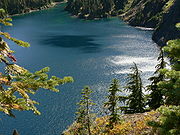
Mountain Hemlock
Tsuga mertensiana, known as Mountain Hemlock, is a species of hemlock native to the west coast of North America, with its northwestern limit on the Kenai Peninsula, Alaska, and its southeastern limit in northern Tulare County, California....
forests, subalpine meadows, streams, lakes, wetlands and avalanche gullies creating distinct patterns of new succession. In the lower ends of this ecoregion there are continuous closed canopy forests while the higher reaches will see mosaics of meadows with patches of Mountain Hemlock forests. The Mountain Hemlock forests consist of Mountain Hemlock, Subalpine fir
Subalpine Fir
The Subalpine Fir or Rocky Mountain Fir is a western North American fir, native to the mountains of Yukon, British Columbia and western Alberta in Canada; southeastern Alaska, Washington, Oregon, Idaho, western Montana, Wyoming, Utah, Colorado, New Mexico, Arizona, northeastern Nevada, and the...
, Alaska yellow-cedar, and Silver Fir
Silver Fir
Abies alba, commonly known as the European silver fir, is a fir native to the mountains of Europe, from the Pyrenees north to Normandy, east to the Alps and the Carpathians, and south to southern Italy and northern Serbia.-Description:...
. Washington’s alpine and subalpine areas account for about 4.4% of its total land area.
Progressing upward from the gradient of Silver Fir and Mountain Hemlock Ecoregions, the mountain hemlock (Tsuga mertensiana) tends to become the dominant conifer, although it may codominate with the Alaska cedar and Pacific silver fir. Mountain hemlock trees live as long as 1000 years: longer than the Pacific silver fir. Trees between 500-700 years may be 100 to 125 ft (30.5 to 38.1 m) tall. Hemlock cones are about 2–3 in (5.1–7.6 cm) in length and develop at the ends of branches. These conifers are easy to distinguish amongst the others with their dense grayish-green needles. According to Franklin and Dyrness, the understory where the mountain hemlock and Pacific silver fir co-dominate is dominated by tall mountain huckleberry
Huckleberry
Huckleberry is a common name used in North America for several species of plants in two closely related genera in the family Ericaceae:* Vaccinium* GaylussaciaHuckleberry may also refer to:-Plants:...
; where the Alaska cedar dominates, the understory is dominated by dense collage of rhododendron
Rhododendron
Rhododendron is a genus of over 1 000 species of woody plants in the heath family, most with showy flowers...
, huckleberry and mountain ash
Sorbus
Sorbus is a genus of about 100–200 species of trees and shrubs in the subfamily Maloideae of the Rose family Rosaceae. Species of Sorbus are commonly known as whitebeam, rowan, service tree, and mountain ash...
.
In the higher boundaries of subalpine ecosystem, where the abiotic conditions are more stressful, trees are clumped together in patchy islands. Trees in this area can be recognized by its krummholz
Krummholz
Krummholz or Krumholtz formation — also called Knieholz — is a particular feature of subarctic and subalpine tree line landscapes. Continual exposure to fierce, freezing winds causes vegetation to become stunted and deformed...
form. Trees of this upper boundary will take on a flag appearance with branches extending from one side indicating the prevailing wind directions. The skirt height of the trees is indicative of the height of snow cover where branches tend not to grow. There are various reasons as to why these trees take this form. Strong winds combined with ice particles will cause abrasion scouring the waxy cuticle from one side of the tree creating damage that will prevent branch formation and growth. In addition, the wind will cause desiccation and evaporation in the needles causing branches to die on this side of the trees.
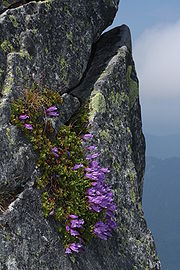
Subalpine Fir
The Subalpine Fir or Rocky Mountain Fir is a western North American fir, native to the mountains of Yukon, British Columbia and western Alberta in Canada; southeastern Alaska, Washington, Oregon, Idaho, western Montana, Wyoming, Utah, Colorado, New Mexico, Arizona, northeastern Nevada, and the...
, and Alaska cedar. Often there are invasions of trees into meadow areas and this reached a peak in the 1930’s due to considerable warming. Invasions of meadows by trees can also occur with disturbances.
The beauty of meadows is very popular amongst hikers. Wildflowers that are found in this ecoregion are the tiger lily
Lilium columbianum
Lilium columbianum is a lily native to western North America. It is also known as the Columbia Lily or Tiger Lily .-Distribution:...
, glacier lily, bead lily, queen's cup, columbine
Aquilegia
Aquilegia is a genus of about 60-70 species of perennial plants that are found in meadows, woodlands, and at higher altitudes throughout the Northern Hemisphere, known for the spurred petals of their flowers.-Etymology:The genus name Aquilegia is derived from the Latin word for eagle , because...
, aster
Astereae
Astereae is a tribe of plants in the family Asteraceae that includes annuals, biennials, perennials, subshrubs, shrubs and trees. Plants within the tribe are present nearly worldwide divided into 170 genera and more than 2,800 species...
, trillium
Trillium
Trillium is a genus of about 40–50 species of spring ephemeral perennials, native to temperate regions of North America and Asia....
, pearly everlasting
Pearly everlasting
Anaphalis is a genus within the composite family whose members are commonly known by the name Pearly everlasting. There are around 110 species within the genus with the vast majority being native to central and southern Asia...
, valerian
Valerian (herb)
Valerian is a hardy perennial flowering plant, with heads of sweetly scented pink or white flowers which bloom in the summer months. Valerian flower extracts were used as a perfume in the sixteenth century....
, skyrocket
Skyrocket
A skyrocket is a type of firework that uses a solid rocket motor to rise quickly into the sky. At the apex of its ascent, it is usual for a variety of effects to be emitted...
, shooting star
Dodecatheon
Dodecatheon is a genus of herbaceous flowering plants in the Primrose family Primulaceae. The species have basal clumps of leaves and nodding flowers that are produced at the top of tall stems that rise from where the leaves join the crown. They are commonly called Shooting Stars because of the...
, penstemon
Penstemon
Penstemon , Beard-tongue, is a large genus of North American and East Asian plants traditionally placed in the Scrophulariaceae family. Due to new genetic research, it has now been placed in the vastly expanded family Plantaginaceae...
, lousewort
Lousewort
Pedicularis is a genus of perennial green root parasite plants belonging to the broomrape family Orobanchaceae. Between 350 and 600 species are accepted by different authorities, mostly from the wetter northern temperate zones, as well as from South America...
, mountain bog gentian
Gentiana calycosa
The herbaceous perennial plant Gentiana calycosa is a species of gentian known by the common names Rainier pleated gentian and Mountain bog gentian....
, monkey flower, monkshood, bluebell
Bluebell
-Plants:* genus Hyacinthoides** Common Bluebell ** Spanish Bluebell * genus Mertensia** Virginia Bluebell * Scottish Bluebell...
, bellflower
Bellflower
The term Bellflower can refer to:*The city of Bellflower, California.*The village of Bellflower, Illinois.* Bellflower, Missouri*Numerous flowering Bellflower plants, classified in the genera Campanula, Campanulastrum, Codonopsis, and Platycodon.*The Bellflower family of rabbits, created by...
, bleeding heart
Dicentra
Dicentra is a genus of 8 species of perennial herbaceous plants in the fumitory family, many with heart-shaped flowers, native to eastern Asia and North America.-Description:...
, Tweedy's lewisia, balsamroot, wild orchids and more. The wildflowers are at their peak in the meadows and along streams from mid-July to mid-August. The parklands of the Mountain Hemlock Ecoregion draw their distinct characteristics from the climate and topography.
The two dominant vegetation types of this mountain region, forests and meadows, have very distinct differences in their microclimate
Microclimate
A microclimate is a local atmospheric zone where the climate differs from the surrounding area. The term may refer to areas as small as a few square feet or as large as many square miles...
s. The amount of solar radiation and UV exposure can vary substantially in our northern latitude largely based on the time of day, slope, season, cloud cover and vegetation. Temperatures adjust accordingly to this solar radiation and exposure. The parklands of this montane region have a much larger range of temperatures as compared to the hemlock forests. The range can be as much as 50 °F (25 °C) while the range in the forests rarely exceeds 20 °F (10 °C). This is due to the canopy of the trees, creating a much more protected environment as compared to the open meadows. In addition soil temperatures directly impact biological activity affecting soil organisms and root systems. Daily and season temperature changes greatly affect the soils' heat loss and gain. However, the snowpack acts as an insulating buffer against temperature change in soils. The Mountain Hemlock forests are the wettest and coldest of the Cascade forest zones.
In the richness of this region many animal species pass through this zone at least one season a year such as mountain goat
Mountain goat
The Mountain Goat , also known as the Rocky Mountain Goat, is a large-hoofed mammal found only in North America. Despite its vernacular name, it is not a member of Capra, the genus of true goats...
, black-tailed deer
Black-tailed Deer
Two forms of black-tailed deer or blacktail deer occupying coastal temperate rainforest on North America's Pacific coast are subspecies of the mule deer. They have sometimes been treated as a species, but virtually all recent authorities maintain they are subspecies...
, American black bear
American black bear
The American black bear is a medium-sized bear native to North America. It is the continent's smallest and most common bear species. Black bears are omnivores, with their diets varying greatly depending on season and location. They typically live in largely forested areas, but do leave forests in...
, elk
Elk
The Elk is the large deer, also called Cervus canadensis or wapiti, of North America and eastern Asia.Elk may also refer to:Other antlered mammals:...
, cougar, and many bird species. Only the whistling hoary marmot
Hoary Marmot
The hoary marmot is a species of marmot that inhabits the mountains of northwest North America. Hoary marmots live near the tree line on slopes with grasses and forbs to eat and rocky areas for cover....
is restricted to alpine and subalpine areas. Besides the richness of mammals there is a richness of insects that are integral to the abundance of flowering plant species in this area. Another important pollinator in this area is the hummingbird
Hummingbird
Hummingbirds are birds that comprise the family Trochilidae. They are among the smallest of birds, most species measuring in the 7.5–13 cm range. Indeed, the smallest extant bird species is a hummingbird, the 5-cm Bee Hummingbird. They can hover in mid-air by rapidly flapping their wings...
. There is still much to be researched and discovered to better understand species interactions and reliance in both the alpine and subalpine ecosystems.
Alpine Ecoregion
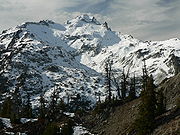
This high elevation habitat of high winds, prolonged snow cover, steep terrain, high temperature variability, and intense UV radiation lead to special species adaptation
Adaptation
An adaptation in biology is a trait with a current functional role in the life history of an organism that is maintained and evolved by means of natural selection. An adaptation refers to both the current state of being adapted and to the dynamic evolutionary process that leads to the adaptation....
s. Alpine regions generally have hypoxic conditions that lead to additional energy expenses for organisms. Increased elevations usually lead to shorter breeding season in animals, as is the case in the alpine ecosystems in the North Cascades. In addition to the shorter breeding season, wildlife often requires seasonal movement to different elevations in order to find adequate food and habitat. However, species such as the White-tailed ptarmigan
White-tailed Ptarmigan
The White-tailed Ptarmigan, Lagopus leucura, is the smallest bird in the grouse family. It is found in the mountains of the western United States, Canada and Alaska.-Description:...
, hoary marmot
Hoary Marmot
The hoary marmot is a species of marmot that inhabits the mountains of northwest North America. Hoary marmots live near the tree line on slopes with grasses and forbs to eat and rocky areas for cover....
s, and pika
Pika
The pika is a small mammal, with short limbs, rounded ears, and short tail. The name pika is used for any member of the Ochotonidae, a family within the order of lagomorphs, which also includes the Leporidae . One genus, Ochotona, is recognised within the family, and it includes 30 species...
s remain in high elevations of the Cascades year round left only to go to patchy and scattered alpine vegetation. The majority of species will move to lower elevations at some time throughout their life history. Adaptations such as torpor in hummingbirds, the ability of mountain goats and coyotes to camouflage in the landscape, animals developing extra fat deposits, and the raptor's ability to move efficiently in the strong winds illustrate just some of the ways species have been ability to cope with alpine conditions. The White-tailed ptarmigan has an adaption of changing its plumage from white in the winter to brown in the summer in order to camouflage. Many species in higher elevations produce fewer offspring than in lower elevations but spend more time nurturing their young.
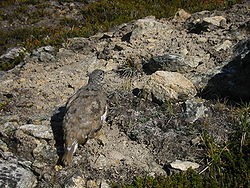
While alpine ecosystems provide challenging abiotic conditions for species there are advantages to animal species to habituate these areas. In the winter while there is extensive snow pack there are also strong winds that will expose herbaceous stems and seeds for animals to forage on. Insects that are blown up from lower elevations will land on the snow beds in the spring offering much nutrition for birds and other mammals that breed in the alpine. When snowfields melt it creates a gradient of plant phenology
Phenology
Phenology is the study of periodic plant and animal life cycle events and how these are influenced by seasonal and interannual variations in climate...
which provides emerging vegetation over a period of time for herbivores to feed on and migrate along this line. Spring foraging is believed to be crucial in the breeding in a number of species such as the mountain goat. Leaf budding and fruiting in late summer past the edges of snowfields also offer food for the animals that depend on this area. Black bear
American black bear
The American black bear is a medium-sized bear native to North America. It is the continent's smallest and most common bear species. Black bears are omnivores, with their diets varying greatly depending on season and location. They typically live in largely forested areas, but do leave forests in...
s, songbirds and marmots in the North Cascades and Alpine Lakes can find cover in lush vegetation in avalanche chutes adjacent to the subalpine forests. There seems to also be evidence that there is a lower rate of parasitism and disease in these high alpine elevations offering yet another advantage to alpine species. The alpine grouse
Grouse
Grouse are a group of birds from the order Galliformes. They are sometimes considered a family Tetraonidae, though the American Ornithologists' Union and many others include grouse as a subfamily Tetraoninae in the family Phasianidae...
is one example of an alpine animal that has few blood infections or intestinal parasites. Other animal species in the summer months will migrate into the higher alpine elevations to avoid insects and forage in the meadows.
Subalpine Fir Ecoregion
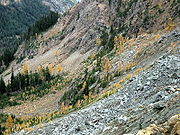
Subalpine Fir
The Subalpine Fir or Rocky Mountain Fir is a western North American fir, native to the mountains of Yukon, British Columbia and western Alberta in Canada; southeastern Alaska, Washington, Oregon, Idaho, western Montana, Wyoming, Utah, Colorado, New Mexico, Arizona, northeastern Nevada, and the...
forests, subalpine meadows, avalanche gullies, and freshwater wetlands, streams and lakes.
The Subalpine Fir forests in the North Cascades include Douglas-fir
Douglas-fir
Douglas-fir is one of the English common names for evergreen coniferous trees of the genus Pseudotsuga in the family Pinaceae. Other common names include Douglas tree, and Oregon pine. There are five species, two in western North America, one in Mexico, and two in eastern Asia...
, Engelmann Spruce
Engelmann Spruce
Picea engelmannii is a species of spruce native to western North America, from central British Columbia and southwest Alberta, southwest to northern California and southeast to Arizona and New Mexico; there are also two isolated populations in northern Mexico...
, Subalpine Larch
Subalpine Larch
Larix lyallii, the Subalpine Larch, or simply Alpine Larch, is a coniferous tree native to northwestern North America. It lives at very high altitudes in the Rocky Mountains of Idaho, Montana, British Columbia, and Alberta...
, and Whitebark Pine
Whitebark Pine
Pinus albicaulis, known commonly as Whitebark Pine, Pitch Pine, Scrub Pine, and Creeping Pine occurs in the mountains of the Western United States and Canada, specifically the subalpine areas of the Sierra Nevada, the Cascade Range, the Pacific Coast Ranges, and the northern Rocky Mountains –...
. The Engelmann Spruce and the Subalpine Fir are commonly found together. In the higher boundaries of this ecoregion the Subalpine Fir takes on the krummholz
Krummholz
Krummholz or Krumholtz formation — also called Knieholz — is a particular feature of subarctic and subalpine tree line landscapes. Continual exposure to fierce, freezing winds causes vegetation to become stunted and deformed...
form. The Subalpine Fir Ecoregion is characterized by its patches of forest and meadows in its upper range similarly to the Mountain Hemlock Ecoregion.
Grand Fir/Douglas Fir Ecoregion
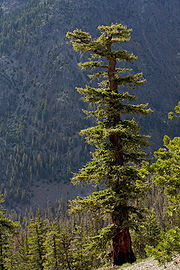
Grand Fir
Abies grandis is a fir native to the Pacific Northwest and Northern California of North America, occurring at altitudes of sea level to 1,800 m...
/Douglas-fir
Douglas-fir
Douglas-fir is one of the English common names for evergreen coniferous trees of the genus Pseudotsuga in the family Pinaceae. Other common names include Douglas tree, and Oregon pine. There are five species, two in western North America, one in Mexico, and two in eastern Asia...
ecoregion with a very diverse forest. This forest has the most diverse trees of the forested ecoregions in Washington state which includes Grand Fir, Douglas-fir, Engelmann Spruce
Engelmann Spruce
Picea engelmannii is a species of spruce native to western North America, from central British Columbia and southwest Alberta, southwest to northern California and southeast to Arizona and New Mexico; there are also two isolated populations in northern Mexico...
, Subalpine Fir
Subalpine Fir
The Subalpine Fir or Rocky Mountain Fir is a western North American fir, native to the mountains of Yukon, British Columbia and western Alberta in Canada; southeastern Alaska, Washington, Oregon, Idaho, western Montana, Wyoming, Utah, Colorado, New Mexico, Arizona, northeastern Nevada, and the...
, Ponderosa Pine
Ponderosa Pine
Pinus ponderosa, commonly known as the Ponderosa Pine, Bull Pine, Blackjack Pine, or Western Yellow Pine, is a widespread and variable pine native to western North America. It was first described by David Douglas in 1826, from eastern Washington near present-day Spokane...
, Lodgepole Pine
Lodgepole Pine
Lodgepole Pine, Pinus contorta, also known as Shore Pine, is a common tree in western North America. Like all pines, it is evergreen.-Subspecies:...
, Western White Pine
Western White Pine
Western White Pine, Pinus monticola in the family Pinaceae, is a species of pine that occurs in the mountains of the western United States and Canada, specifically the Sierra Nevada, the Cascade Range, the Coast Range, and the northern Rocky Mountains. The tree extends down to sea level in many...
, Whitebark Pine
Whitebark Pine
Pinus albicaulis, known commonly as Whitebark Pine, Pitch Pine, Scrub Pine, and Creeping Pine occurs in the mountains of the Western United States and Canada, specifically the subalpine areas of the Sierra Nevada, the Cascade Range, the Pacific Coast Ranges, and the northern Rocky Mountains –...
, Western Larch
Western Larch
Western Larch is a species of larch native to the mountains of western North America, in Canada in southeastern British Columbia and southwestern Alberta, and in the United States in eastern Washington, eastern Oregon, northern Idaho and western Montana.It is a large deciduous coniferous tree...
, and Subalpine Larch
Subalpine Larch
Larix lyallii, the Subalpine Larch, or simply Alpine Larch, is a coniferous tree native to northwestern North America. It lives at very high altitudes in the Rocky Mountains of Idaho, Montana, British Columbia, and Alberta...
. This ecoregion has an annual mean temperature of 46 °F (7.8 °C) and receives between 60–110 cm (23.6–43.3 in) of precipitation per year. The elevation range of this ecoregion is between 2000–5000 ft (609.6–1,524 m).
In the upper regions of this ecoregion, the dominant conifers are the Mountain Hemlock and Subalpine Fir and in the lower boundary the Grand Fir
Grand Fir
Abies grandis is a fir native to the Pacific Northwest and Northern California of North America, occurring at altitudes of sea level to 1,800 m...
and Douglas-fir dominate. There is a variety of understory vegetation in this ecoregion that includes pinegrass, elk sedge
Carex geyeri
Carex geyeri is a species of sedge known by the common names Geyer's sedge and elk sedge. It is native to western North America from British Columbia to California to Colorado, where it grows in dry areas in mountain meadows, grasslands, and open forest. This sedge produces scattered tufts of stems...
, sedges
Cyperaceae
Cyperaceae are a family of monocotyledonous graminoid flowering plants known as sedges, which superficially resemble grasses or rushes. The family is large, with some 5,500 species described in about 109 genera. These species are widely distributed, with the centers of diversity for the group...
, low shrubs, vine maple
Vine Maple
Acer circinatum is a species of maple native to western North America, from southwest British Columbia to northern California, always within 300 km of the Pacific Ocean coast....
, white alder
Alnus rhombifolia
Alnus rhombifolia, the White Alder, is an alder tree native to western North America, from Washington east to western Montana, southeast to the Sierra Nevada, and south through the Peninsular Ranges and Colorado Desert oases in Southern California. It occurs in riparian zone habitats at an...
, and huckleberry
Huckleberry
Huckleberry is a common name used in North America for several species of plants in two closely related genera in the family Ericaceae:* Vaccinium* GaylussaciaHuckleberry may also refer to:-Plants:...
. This diverse landscape offers habitat to many species including grazers such as deer
Deer
Deer are the ruminant mammals forming the family Cervidae. Species in the Cervidae family include white-tailed deer, elk, moose, red deer, reindeer, fallow deer, roe deer and chital. Male deer of all species and female reindeer grow and shed new antlers each year...
, elk
Elk
The Elk is the large deer, also called Cervus canadensis or wapiti, of North America and eastern Asia.Elk may also refer to:Other antlered mammals:...
, black bear
American black bear
The American black bear is a medium-sized bear native to North America. It is the continent's smallest and most common bear species. Black bears are omnivores, with their diets varying greatly depending on season and location. They typically live in largely forested areas, but do leave forests in...
, herbivores, and a variety of birds.
Fauna
A variety of reptileReptile
Reptiles are members of a class of air-breathing, ectothermic vertebrates which are characterized by laying shelled eggs , and having skin covered in scales and/or scutes. They are tetrapods, either having four limbs or being descended from four-limbed ancestors...
s, amphibian
Amphibian
Amphibians , are a class of vertebrate animals including animals such as toads, frogs, caecilians, and salamanders. They are characterized as non-amniote ectothermic tetrapods...
s, mammal
Mammal
Mammals are members of a class of air-breathing vertebrate animals characterised by the possession of endothermy, hair, three middle ear bones, and mammary glands functional in mothers with young...
s, birds and arthropod
Arthropod
An arthropod is an invertebrate animal having an exoskeleton , a segmented body, and jointed appendages. Arthropods are members of the phylum Arthropoda , and include the insects, arachnids, crustaceans, and others...
s are found in the North Cascades. Examples of species occurring in the North Cascades include the western toad, Bufo boreas, and the rough-skinned newt, Taricha granulosa. An unusual feature of the Rough-skinned Newt Cascade Mountains populations, approximately ninety percent of the adult population is perennibranchiate
Perennibranchiate
Perennibranchiate, in zoology, is the condition of an organism retaining branchae, or gills, through life; This condition is generally said of certain amphibia, such as the menobranchus; the term is opposed to caducibranchiate...
. A small number of grizzly bear
Grizzly Bear
The grizzly bear , also known as the silvertip bear, the grizzly, or the North American brown bear, is a subspecies of brown bear that generally lives in the uplands of western North America...
s (Ursus arctos horribilis) inhabit the far northern Cascades, near the American-Canadian border. A breeding pack of wolves
Gray Wolf
The gray wolf , also known as the wolf, is the largest extant wild member of the Canidae family...
was confirmed in Okanogan County in 2008, the first such pack in Washington state since the 1930's.
See also
- Alpine Lakes WildernessAlpine Lakes WildernessThe Alpine Lakes Wilderness is a large wilderness area spanning the Cascade Range of Washington state in the United States. The wilderness is located in parts of Wenatchee National Forest and Snoqualmie National Forest, and is approximately bounded by Interstate 90 and Snoqualmie Pass to the south...
- Glacier Peak WildernessGlacier Peak WildernessThe Glacier Peak Wilderness, created by the US Forest Service in 1960 by efforts of the , four years before the 1964 wilderness legislation of the Congress, is located within portions of Chelan County, Snohomish County, and Skagit Counties in the North Cascades of Washington...
- Henry M. Jackson WildernessHenry M. Jackson WildernessThe Henry M. Jackson Wilderness is a U.S. Wilderness Area in the state of Washington, United States.-History:The Henry M. Jackson Wilderness was created by the 1984 Washington Wilderness Act and named after former US Senator Henry M. Jackson of Washington...
- North Cascades National ParkNorth Cascades National ParkNorth Cascades National Park is a U.S. National Park located in the state of Washington. The park is the largest of the three National Park Service units that comprise the North Cascades National Park Service Complex. Several national wilderness areas and British Columbia parkland adjoin the...
- Ecozones of CanadaEcozones of CanadaThe ecozones of Canada consist of fifteen terrestrial and five marine ecozones in Canada. These are further subdivided into 53 ecoprovinces, 194 ecoregions, and 1021 ecodistricts...
- Biogeoclimatic zones of British ColumbiaBiogeoclimatic zones of British ColumbiaBiogeoclimatic zones of British Columbia are a classification system ciosed by the British Columbia Ministry of Forests for the Canadian province's many different ecosystems...

